Herzog Anton Ulrich Museum
The Herzog Anton Ulrich Museum (HAUM) is an art museum in the German city of Braunschweig, Lower Saxony.[1]
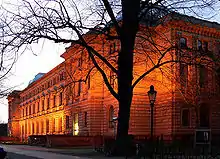 Herzog Anton Ulrich Museum | |

| |
| Established | 1754 |
|---|---|
| Location | Braunschweig, Germany |
| Type | Art museum |
| Architect | Oskar Sommer |
| Owner | Niedersächsische Landesmuseen Braunschweig |
| Website | Official website |
History
Founded in 1754, the Herzog Anton Ulrich Museum is one of the oldest museums in Europe. The museum has its origins in the art and natural history cabinet of Duke Charles I of Brunswick, which he opened in 1754 at the suggestion of the Dutch physician Daniel de Superville. It was one of the first museums in Germany to open to the public and was opened only one year after the British Museum in London. This "cabinet" included a collection of handicraft works and sculptures from the Baroque and Renaissance, but also ancient works of art from outside Europe. The natural history collection later became the basis of the Natural History Museum.[2]
The current museum building was opened in 1887. Its architect, Oskar Sommer, planned the building in Italian Renaissance style. In 2010 an extension building was added to the museum. The historical building was closed for renovation for seven years.[3] The museum reopened on 23 October 2016.
Collection
The museum houses an important collection of Western old master paintings, and is especially strong in Northern European art since the Renaissance, including works by Cranach (a very strong collection), Holbein, Dürer, Van Dyck, Rubens, and Rembrandt. Rarities include a single work each by Vermeer, Giorgione and Rosso Fiorentino. The museum is based on the Schloss Salzdahlum art collection of Anthony Ulrich, Duke of Brunswick-Lüneburg (1633–1714), after whom it is named. In old catalogs, the term Bilder-Galerie zu Salzthalen refers to this collection.
The print room, with over 100,000 prints and 10,000 drawings, is of international importance. There are also temporary exhibitions of art from all over the world. Among the manuscript items is the journal of Matthaeus Schwarz, an accountant very interested in fashion who documented his outfits throughout his adult life at a time when it was thought that people not of the highest rank dressed drably. It is the first known fashion book.[4]
The museum's collection of medieval objects is housed at Dankwarderode Castle.[5]
Selected works in the museun
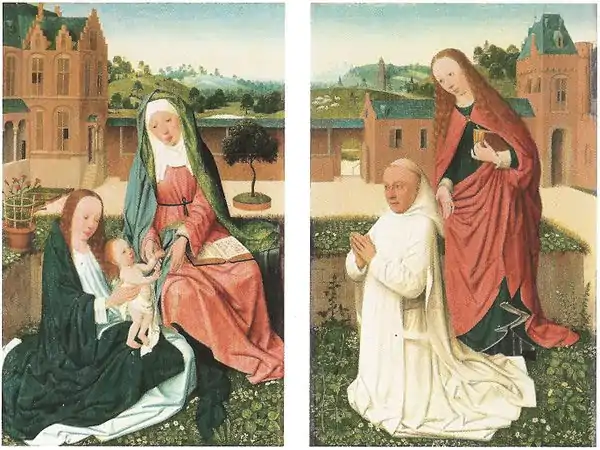 Brunswick Diptych, by the Master of the Brunswick Diptych, c. 1490
Brunswick Diptych, by the Master of the Brunswick Diptych, c. 1490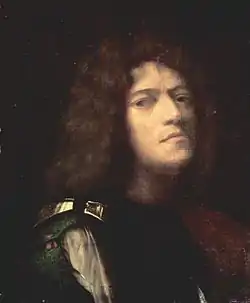 Self-portrait as David, by Giorgione, c. 1500
Self-portrait as David, by Giorgione, c. 1500 Abduction of Proserpine on a Unicorn, etching by Albrecht Dürer, 1516
Abduction of Proserpine on a Unicorn, etching by Albrecht Dürer, 1516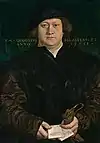 Portrait of Cyriacus Kale, by Hans Holbein the Younger, 1533
Portrait of Cyriacus Kale, by Hans Holbein the Younger, 1533.jpg.webp) Hercules and Omphale, by Lucas Cranach the Elder, 1537
Hercules and Omphale, by Lucas Cranach the Elder, 1537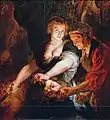 Judith with the Head of Holofernes, by Peter Paul Rubens, 1616
Judith with the Head of Holofernes, by Peter Paul Rubens, 1616 The Girl with the Wine Glass, by Johannes Vermeer, c. 1659
The Girl with the Wine Glass, by Johannes Vermeer, c. 1659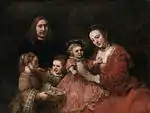 Portrait of a Family, by Rembrandt, 1668/69
Portrait of a Family, by Rembrandt, 1668/69.jpg.webp) Portrait of Gottfried Wilhelm Leibniz, by Christoph Bernhard Francke, c. 1695
Portrait of Gottfried Wilhelm Leibniz, by Christoph Bernhard Francke, c. 1695 Portrait of a Young Woman, by Jan Kupecký, c. 1710
Portrait of a Young Woman, by Jan Kupecký, c. 1710
References
- "Die Kunst ist zurück". Zeit Online (in German).
- "Das Herzog Anton Ulrich-Museum". 3landesmuseen.de (in German).
- "Herzog Anton Ulrich-Museum Reopened after Renovation". codart.nl.
- "BBC News - Fashion: The accountant who created the first book of fashion". BBC News.
- "Die Mittelalterausstellung in der Burg Dankwarderode". 3landesmuseen.de (in German).
External links
- Official website (in German)
| Wikimedia Commons has media related to Herzog-Anton-Ulrich-Museum Braunschweig. |